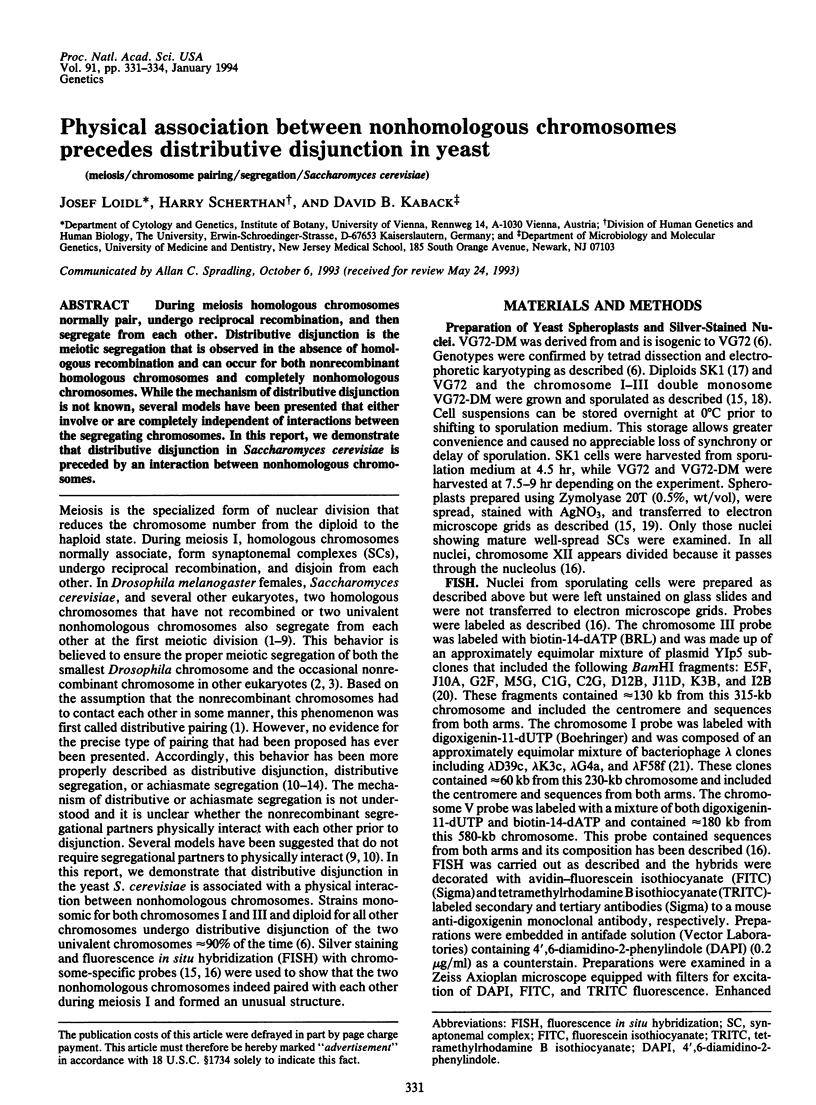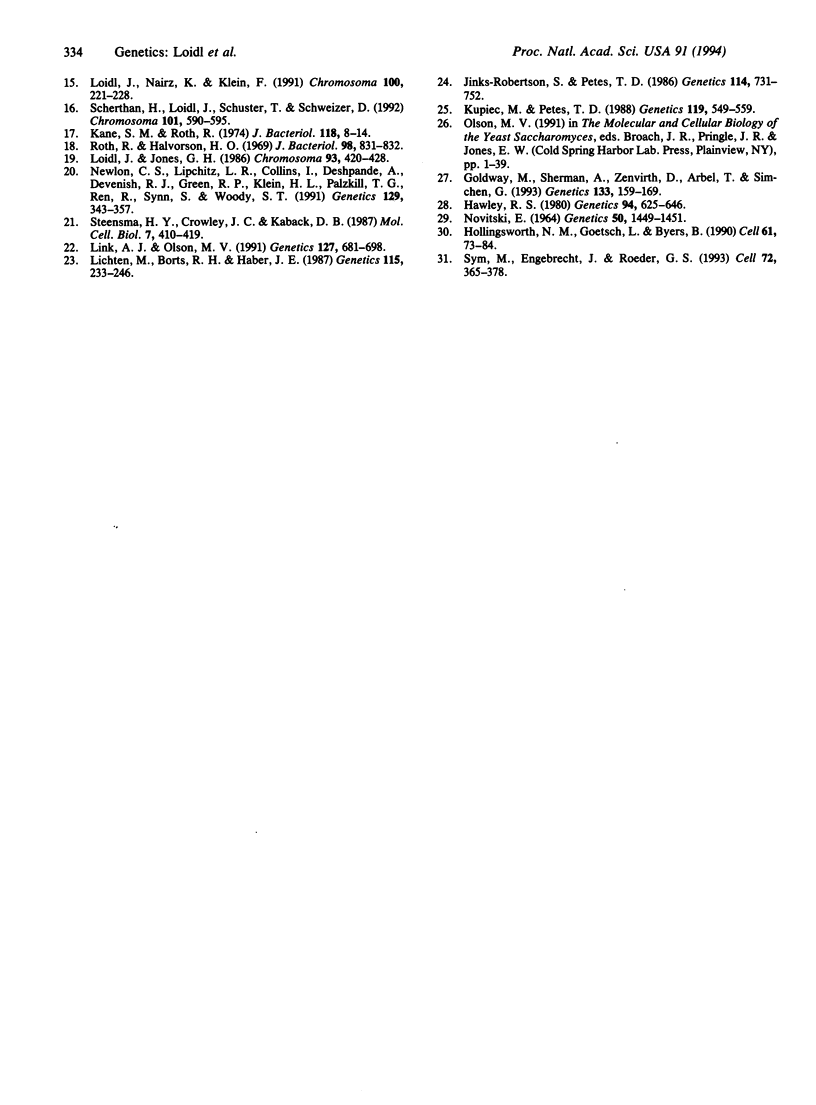Abstract
During meiosis homologous chromosomes normally pair, undergo reciprocal recombination, and then segregate from each other. Distributive disjunction is the meiotic segregation that is observed in the absence of homologous recombination and can occur for both nonrecombinant homologous chromosomes and completely nonhomologous chromosomes. While the mechanism of distributive disjunction is not known, several models have been presented that either involve or are completely independent of interactions between the segregating chromosomes. In this report, we demonstrate that distributive disjunction in Saccharomyces cerevisiae is preceded by an interaction between nonhomologous chromosomes.
Full text
PDF



Images in this article
Selected References
These references are in PubMed. This may not be the complete list of references from this article.
- Baker B. S., Carpenter A. T., Esposito M. S., Esposito R. E., Sandler L. The genetic control of meiosis. Annu Rev Genet. 1976;10:53–134. doi: 10.1146/annurev.ge.10.120176.000413. [DOI] [PubMed] [Google Scholar]
- Carpenter A. T. Distributive segregation: motors in the polar wind? Cell. 1991 Mar 8;64(5):885–890. doi: 10.1016/0092-8674(91)90313-n. [DOI] [PubMed] [Google Scholar]
- Dawson D. S., Murray A. W., Szostak J. W. An alternative pathway for meiotic chromosome segregation in yeast. Science. 1986 Nov 7;234(4777):713–717. doi: 10.1126/science.3535068. [DOI] [PubMed] [Google Scholar]
- Endow S. A. Meiotic chromosome distribution in Drosophila oocytes: roles of two kinesin-related proteins. Chromosoma. 1992 Dec;102(1):1–8. doi: 10.1007/BF00352283. [DOI] [PubMed] [Google Scholar]
- GRELL R. F. A new hypothesis on the nature and sequence of meiotic events in the female of Drosophila melanogaster. Proc Natl Acad Sci U S A. 1962 Feb;48:165–172. doi: 10.1073/pnas.48.2.165. [DOI] [PMC free article] [PubMed] [Google Scholar]
- Goldway M., Sherman A., Zenvirth D., Arbel T., Simchen G. A short chromosomal region with major roles in yeast chromosome III meiotic disjunction, recombination and double strand breaks. Genetics. 1993 Feb;133(2):159–169. doi: 10.1093/genetics/133.2.159. [DOI] [PMC free article] [PubMed] [Google Scholar]
- Guacci V., Kaback D. B. Distributive disjunction of authentic chromosomes in Saccharomyces cerevisiae. Genetics. 1991 Mar;127(3):475–488. doi: 10.1093/genetics/127.3.475. [DOI] [PMC free article] [PubMed] [Google Scholar]
- Hawley R. S. Chromosomal sites necessary for normal levels of meiotic recombination in Drosophila melanogaster. I. Evidence for and mapping of the sites. Genetics. 1980 Mar;94(3):625–646. doi: 10.1093/genetics/94.3.625. [DOI] [PMC free article] [PubMed] [Google Scholar]
- Hawley R. S., Irick H., Zitron A. E., Haddox D. A., Lohe A., New C., Whitley M. D., Arbel T., Jang J., McKim K. There are two mechanisms of achiasmate segregation in Drosophila females, one of which requires heterochromatic homology. Dev Genet. 1992;13(6):440–467. doi: 10.1002/dvg.1020130608. [DOI] [PubMed] [Google Scholar]
- Hollingsworth N. M., Goetsch L., Byers B. The HOP1 gene encodes a meiosis-specific component of yeast chromosomes. Cell. 1990 Apr 6;61(1):73–84. doi: 10.1016/0092-8674(90)90216-2. [DOI] [PubMed] [Google Scholar]
- Jinks-Robertson S., Petes T. D. Chromosomal translocations generated by high-frequency meiotic recombination between repeated yeast genes. Genetics. 1986 Nov;114(3):731–752. doi: 10.1093/genetics/114.3.731. [DOI] [PMC free article] [PubMed] [Google Scholar]
- Kaback D. B. Meiotic segregation of circular plasmid-minichromosomes from intact chromosomes in Saccharomyces cerevisiae. Curr Genet. 1989 Jun;15(6):385–392. doi: 10.1007/BF00376792. [DOI] [PubMed] [Google Scholar]
- Kane S. M., Roth R. Carbohydrate metabolism during ascospore development in yeast. J Bacteriol. 1974 Apr;118(1):8–14. doi: 10.1128/jb.118.1.8-14.1974. [DOI] [PMC free article] [PubMed] [Google Scholar]
- Kupiec M., Petes T. D. Allelic and ectopic recombination between Ty elements in yeast. Genetics. 1988 Jul;119(3):549–559. doi: 10.1093/genetics/119.3.549. [DOI] [PMC free article] [PubMed] [Google Scholar]
- Lichten M., Borts R. H., Haber J. E. Meiotic gene conversion and crossing over between dispersed homologous sequences occurs frequently in Saccharomyces cerevisiae. Genetics. 1987 Feb;115(2):233–246. doi: 10.1093/genetics/115.2.233. [DOI] [PMC free article] [PubMed] [Google Scholar]
- Link A. J., Olson M. V. Physical map of the Saccharomyces cerevisiae genome at 110-kilobase resolution. Genetics. 1991 Apr;127(4):681–698. doi: 10.1093/genetics/127.4.681. [DOI] [PMC free article] [PubMed] [Google Scholar]
- Loidl J., Nairz K., Klein F. Meiotic chromosome synapsis in a haploid yeast. Chromosoma. 1991 May;100(4):221–228. doi: 10.1007/BF00344155. [DOI] [PubMed] [Google Scholar]
- Mann C., Davis R. W. Meiotic disjunction of circular minichromosomes in yeast does not require DNA homology. Proc Natl Acad Sci U S A. 1986 Aug;83(16):6017–6019. doi: 10.1073/pnas.83.16.6017. [DOI] [PMC free article] [PubMed] [Google Scholar]
- NOVITSKI E. AN ALTERNATIVE TO THE DISTRIBUTIVE PAIRING HYPOTHESIS IN DROSOPHILA. Genetics. 1964 Dec;50:1449–1451. doi: 10.1093/genetics/50.6.1449. [DOI] [PMC free article] [PubMed] [Google Scholar]
- Newlon C. S., Lipchitz L. R., Collins I., Deshpande A., Devenish R. J., Green R. P., Klein H. L., Palzkill T. G., Ren R. B., Synn S. Analysis of a circular derivative of Saccharomyces cerevisiae chromosome III: a physical map and identification and location of ARS elements. Genetics. 1991 Oct;129(2):343–357. doi: 10.1093/genetics/129.2.343. [DOI] [PMC free article] [PubMed] [Google Scholar]
- Roth R., Halvorson H. O. Sporulation of yeast harvested during logarithmic growth. J Bacteriol. 1969 May;98(2):831–832. doi: 10.1128/jb.98.2.831-832.1969. [DOI] [PMC free article] [PubMed] [Google Scholar]
- Scherthan H., Loidl J., Schuster T., Schweizer D. Meiotic chromosome condensation and pairing in Saccharomyces cerevisiae studied by chromosome painting. Chromosoma. 1992 Oct;101(10):590–595. doi: 10.1007/BF00360535. [DOI] [PubMed] [Google Scholar]
- Steensma H. Y., Crowley J. C., Kaback D. B. Molecular cloning of chromosome I DNA from Saccharomyces cerevisiae: isolation and analysis of the CEN1-ADE1-CDC15 region. Mol Cell Biol. 1987 Jan;7(1):410–419. doi: 10.1128/mcb.7.1.410. [DOI] [PMC free article] [PubMed] [Google Scholar]
- Sym M., Engebrecht J. A., Roeder G. S. ZIP1 is a synaptonemal complex protein required for meiotic chromosome synapsis. Cell. 1993 Feb 12;72(3):365–378. doi: 10.1016/0092-8674(93)90114-6. [DOI] [PubMed] [Google Scholar]
- Virkki N. Orientation and segregation of asynaptic multiple sex chromosomes in the male Omophoita clerica Erichson (Coleoptera: Alticidae). Hereditas. 1967;57(1):275–288. doi: 10.1111/j.1601-5223.1967.tb02107.x. [DOI] [PubMed] [Google Scholar]




